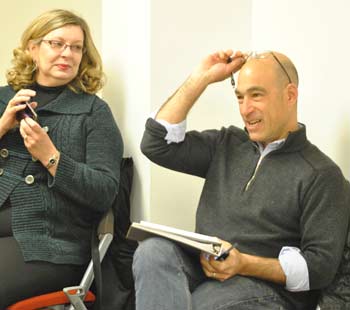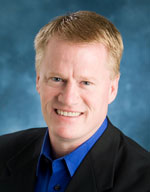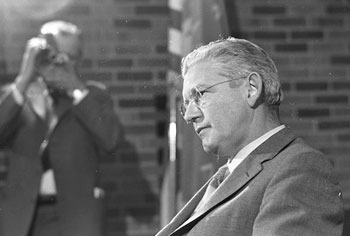Ann Arbor public art commission special meeting (March 7, 2013): Because attendance was low at AAPAC’s regular meeting in late February, commissioners held a special meeting the following week to wrap up items that hadn’t been addressed.

Bob Miller, right, is the new chair of the Ann Arbor public art commission. To the left is Deb Polich, executive director of the nonprofit Arts Alliance. They were attending the March 15 meeting of the city council’s public art committee, which is developing revisions to the city’s public art ordinance. (Photos by the writer.)
Commissioners voted to accept a memorial for Coleman Jewett as an official AAPAC project and to approve Sarah Gay as a volunteer project manager. Her duties would be to lead efforts for city council approval, donor relations and fundraising. John Kotarski advocated for less involvement from AAPAC, saying he hoped to streamline the project.
However, other commissioners felt it should be handled like other projects, with oversight by AAPAC. The proposal is for a bronze Adirondack chair at the Ann Arbor farmers market. The city’s market manager, Sarah DeWitt, attended the March 7 meeting and will help coordinate the project.
Commissioners also voted to increase the honorariums for artists who have been selected as finalists for a $400,000 project at the East Stadium bridge. The overall project amount remains unchanged, but honorariums were raised from $2,000 to $3,000 for each of the four finalists: Volkan Alkanoglu, based in Atlanta, Georgia; Sheila Klein of Bow, Washington; Rebar Group of San Francisco; and Catherine Widgery of Cambridge, Mass. They will be in town on April 1 for a site visit and public open house.
Another effort that’s in the early phases got a vote of support from commissioners, but no financial commitment at this point. The project will use old aluminum canoes from the city of Ann Arbor’s Argo canoe livery, which artists and community groups will turn into artwork that will be displayed throughout the downtown in 2014. Partners in the project include the Ann Arbor Area Convention & Visitors Bureau (CVB), the Main Street Area Association (MSAA), the Arts Alliance, and the Huron River Watershed Council. AAPAC is involved only in a supportive role, to help with public engagement.
The role of public engagement was part of a discussion regarding AAPAC’s annual public art plan, which is due to the city council on April 1. Some commissioners expressed frustration at the process, given the uncertainty of the public art program’s future. Ultimately, they gave guidance to Aaron Seagraves, the city’s public art administrator, to draft a plan that includes projects in highly-visible, highly-used locations, currently underserved in terms of public art.
The March 7 meeting also included the election of officers. Bob Miller was elected the new chair, replacing Marsha Chamberlin. Kotarski abstained from voting. He noted that the commission will soon be at only 40% capacity – a reference to the fact that there are three vacancies on the nine-member commission, with an additional resignation expected by Wiltrud Simbuerger in the near future.
Two of those vacancies will likely be filled shortly. Nominations are on the city council’s March 18 agenda for confirmation: Nick Zagar, an artist and commercial real estate agent who serves on the Ann Arbor Art Center board; and Ashlee Arder, programs coordinator at ArtServe Michigan.
All of these actions come in the context of the city council’s ongoing review of the city’s public art program, which began in early December of 2012. This article begins with a report on the most recent meeting of the council’s public art committee on Friday, March 15. An update of their work will be attached to the council’s March 18 agenda as an item of communication. Their next committee meeting is scheduled for March 28. [Full Story]








